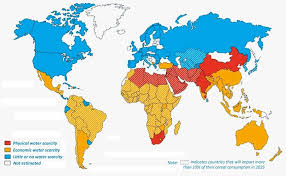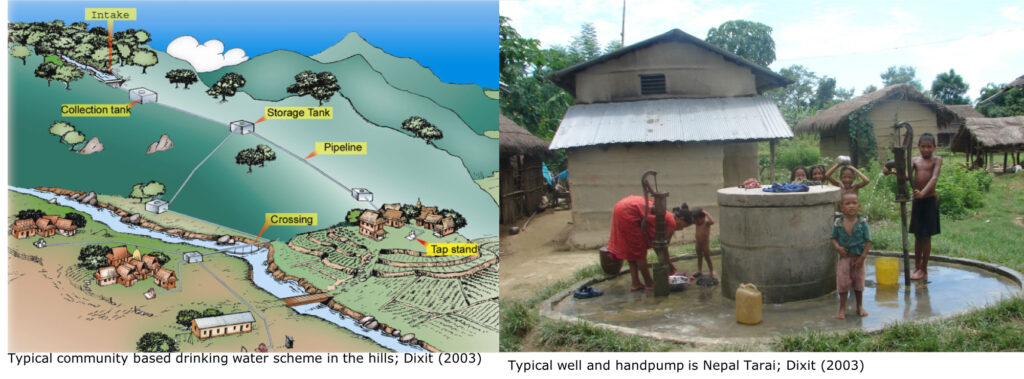Water scarcity is one of the biggest and underrated challenge that we are facing right now. Due to rapid rise in urbanisation, change in climate patterns and lifestyle, water especially freshwater has become a luxury asset among people, because of its less supply and huge demand. In this blog, we will discuss more about the associated problems with this and some innovative solutions to ensure freshwater to each and everyone.

The Two Forms of Water Scarcity: Physical and Economic
Water Scarcity can be seen in two forms: Physical and Economical. Physical water scarcity occurs whenever there is a large demand for water, whereas the supply may be low for a given region. This mainly occurs when the consumption of the water increases during summer, climatic impact like drought and may be due to the deplection of groundwater resources.

On the other hand, economic water scarcity occurs when there is a shortage of budget for water infrastructure. This often results into poor water treatment, lack of storage facilities and distribution channels. It is always crucial to understand these types to find a proper solution according to the situation.
The Global Scale of this Problem
The volume of water scarcity is skyrocketing. In 2016, around 933 million people ( one-third of the world population) faced water scarcity. But studies shows that this number will surge to 1.694- 2.373 billion people ( from 1-third to nearly half of the world population) by 2050 and this data is really shocking.

India is also witnessing to be the most affected country, with an expected increase of 153-422 million people facing water shortage in urban areas. On top of this, the number of cities highly exposed to water scarcity is expected to rise from 193 to 193-284, including 10-20 megacities.
Future Challenges of Water Scarcity
Water scarcity has many consequences for human health, food security and cleanliness. Due to lack of clean water, this not only affects the daily routines, but paves way to deadly waterborne diseases, especially this will very badly for children and vulnerable populations.
Agriculture is another area which is affected the most. We can only produce high quality crops, if it is properly cultivated. Balancing the water needs for agriculture with those of urban areas and ecosystems will be a critical challenge in the upcoming decades. By implementing advanced and innovative irrigation techniques, drought-resistant crops, and more efficient water use is vital to overcome this problem.
Rapid migration around the world creating an unfair pressure on water resources and management. As a result of this, most people need to adjust with the available water wheather it is dirty or not. By 2050, around half the world population will face a water crisis and inorder to overcome this issues, sustainable water management styles needs to be implemented.
Smart Solutions and Innovations to solve this problem
Inorder to solve this huge issue, we need to implement a bunch of creative measures and this includes a range of technological, policy and innovations. These remedies align closely to the Sustainable Development Goals (SDG) 9 (Industry, Innovation and Infrastructure) and 13 (Climate Action). Here’s a detailed explantion of these smart and vibrant solutions.
1. Technological Innovations:
a) Advanced Water Treatment and Sourcing:
- We can use advanced technologies such as nanotechnology and membrane technology for wastewater treatment and water purification.
- Promote rainwater harvesting and recycled wastewater systems.
- Implementation of solar powered (which is a renewable energy) reverse osmosis for desalination.

These practices supports both SDG 9 (promoting sustainable industrialisation) and SDG 13 (developing climate-resilient water sources).
b) Precision Agriculture
- Installing smart sensor’s for tracking real time condition of crops.
- Development of drought resistant crops.
- Artificial intelligence systems that optimise water usage based on conditions such as weather conditions and crop needs.
These technologies supports SDG 9 by improving agricultural productivity and SDG 13 by promoting climate-smart agricultural practices.
c) Smart Water Management Systems
- Implementing smart sensors to detect leaks in water infrastructure.
- AI and IoT-based systems to optimise water distribution, detect any issues and future prediction analysis.
- Building smart water grids that adjusts water flow based upon the requirements of the user.

These ideas directly support SDG 9 by promoting innovative infrastructure and fostering technological progress in water management. These also contribute to SDG 13 by improving resource efficiency and by reducing water losses.
2. Policy and Management Innovations:
a) Integreted Water Resources Management (IWRM):
- Balancing social equity, economic efficiency and environmental sustainablility
- Managing land, water and related resources.
This approach matches to SDG 9’s focus on sustainable infrastructure and SDG 13’s emphasis on climate-resilient development.
b) Water Pricing Strategies
- Promotion of water efficient equipments and practices.
- Seasonal rates to adjust with the demand during off seasons.
- Flexible pricing structures to support conservation.

These implementations support SDG 9 by promoting resource-use efficiency and SDG 13 by promoting sustainable patterns.
c) Transboundary Water Management
- Deploying monitoring and management systems for cross-border watersheds.
- Signing international agreements for shared water resources or contracts.
This once again supports SDG 9’s goal of good infrastructure and SDG 13’s view of international coordination.
3. Social and Behavioral Innovations:
a) Community-Based Water Management:
- Incorporating advanced technologies in water management strategies.
- Organise decision making processes in a well planned way, especially in resource management.
- Local groups to share resources, ensuring that water is available to everyone.

This approach support’s SDG 9’s goal of better infrastructure and SDG 13’s vision of community building.
b) Conducting Workshops and Awareness Programs:
- Public and social media campaigns for water saving tips and tricks.
- Virtual reality experiences for showing the importance of water in life.
- Conducting gaming zones on water usage among youngsters.
These programs aligns to the goals of SDG 13 by creating awareness about climate changes, importance of water resources and promoting sustainable patterns.
4. Green Infrastructure:
a) Building Green Infrastructure:
- Artificial forests for water retention and better air quality.
- Raingardens for a better stormwater management system.

Green infrastructure supports both SDG 9’s resilient infrastructure and SDG 13 ‘s ecosystem-based adaptation
.b) Water-Smart Cities:
- Designing urban areas with water conservation in mind.
- Implementing rainwater harvesting systems.
- Developing green spaces that double as flood management areas.
These urban innovations align with SDG 9’s focus on sustainable urbanisation and SDG 13’s goal on climate-resilient development.
Conclusion
In conclusion addressing water scarcity is not for just today’s need, but also for the need for the future generation. This not only helps in improving water managment system but also to a new gate of sustainable growth in long term. By implementing advanced water management technologies, effective policy reforms, and better community engagement, we can create a best water management system that has a very bright and long lasting future ahead. These goals aligns with SDG 9 and 13, promoting sustainable industrialisation, innovation and climate action. As we are moving forward, we need to stick to this framework for further advancements, so that we can make this even better with a lot of more advantages and benefits.